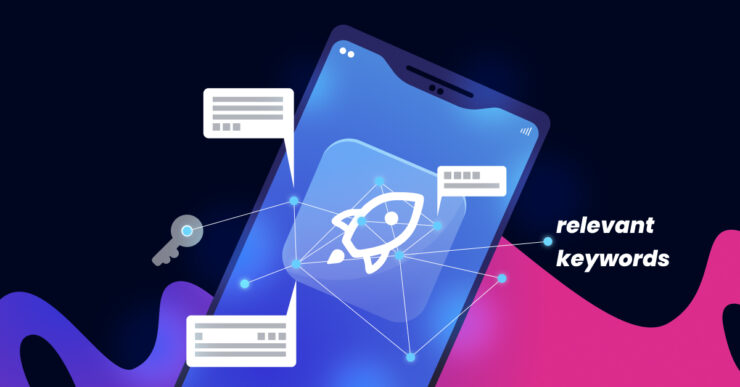One of the most effective tools for achieving success with your application is the creation of a semantic core. A semantic core allows you to precisely determine which keywords and phrases are most relevant to your app, significantly boosting its visibility in search engines and app stores. Crafting a semantic core requires a comprehensive approach, involving audience research, keyword collection and analysis, and integration into the metadata and content of your application. This process not only helps attract more users but also enhances engagement by providing exactly what they are seeking.
In this article, we will explore all the stages of creating a semantic core for a mobile application. We’ll discuss how to identify and analyze your target audience, which tools to use for keyword selection, how to evaluate their effectiveness, and how to properly integrate them into your app. By following our recommendations, you’ll be able to build a strong semantic core that will help your app claim a leading position in its niche.
Understanding Semantic Core
A semantic core is a set of keywords and phrases that accurately reflect the content and theme of your application. These keywords are selected based on user queries and analyzed to enhance the visibility and relevance of your app in search engines and app stores. Creating a semantic core involves collecting, analyzing, and structuring keywords that will make your app easily discoverable by your target audience.
The Role of Semantic Core in SEO and ASO (App Store Optimization)
The semantic core plays a crucial role in both SEO (Search Engine Optimization) and ASO (App Store Optimization). In the context of SEO, the semantic core helps optimize app content for search engines such as Google, Bing, and others. This includes using keywords in the app description, titles, meta tags, and other content elements that are indexed by search engines.
In ASO, the semantic core helps improve the visibility of the app in app stores such as Google Play and the App Store. This is achieved by optimizing the app name, subtitles, descriptions, and tags to align with the most popular and relevant user search queries. As a result, your product becomes more visible to potential users, leading to increased downloads and improved app ratings.
By implementing a well-crafted semantic core, you can enhance the discoverability and relevance of your app, ultimately driving its success in the competitive landscape of mobile applications.
Successful Examples of Semantic Core Utilization in Applications
Example 1: Fitness Application
For a home workout-focused fitness application, a semantic core was developed, including keywords such as “home workouts,” “equipment-free exercises,” “fitness for beginners.” By using these keywords in the title, description, and content of the application, the app was able to achieve high rankings in search results and app stores. This led to a significant increase in downloads and positive reviews.
Example 2: Language Learning Application
A language learning application utilized keywords such as “learn Spanish,” “online English courses,” “master French.” Optimization of metadata and content with these keywords helped attract the target audience and increase the number of active users. The app also received positive ratings for its relevance and usefulness, strengthening its position in the market.
These examples demonstrate how a well-selected semantic core can significantly improve the visibility and success of an application. Creating and optimizing a semantic core requires careful analysis and ongoing adjustments, but the results are worth the effort.
Researching and Analyzing the Target Audience
The first step in creating a semantic core is defining the target audience of your application. The target audience is the group of users for whom your application is intended. It is determined by various parameters such as age, gender, geographical location, socio-economic status, interests, and behavior. Understanding your target audience allows you to create content and functionality that best meets their needs and preferences.
To define your target audience, ask yourself the following questions:
- Who will be the primary users of my application?
- What are their main problems or needs that my application can address?
- What devices and platforms do they prefer to use?
- What are their behavioral characteristics when using mobile applications?
By answering these questions, you can gain valuable insights into your target audience and tailor your semantic core to effectively reach and engage them.
Analyzing the Needs and Interests of the Target Audience
After defining the target audience, it’s essential to conduct a deeper analysis of their needs and interests. This stage involves studying which features and characteristics of the application will be most in demand and useful for users. Analyzing the needs and interests helps create an application that not only attracts users but also retains them, ensuring a high level of satisfaction and loyalty.
Here are several methods for analyzing the needs and interests of the target audience:
- Surveys and Interviews: Conduct surveys and interviews among potential users to understand their preferences and expectations.
- Competitor Analysis: Study competitor applications to understand which features and characteristics attract their audience.
- Social Media and Forums: Monitor discussions on social media and thematic forums to identify current trends and user preferences.
Using Analytical Tools for Data Collection
For a more accurate and detailed analysis of the target audience, various analytical tools can be used. These tools allow you to collect and analyze data on user behavior, preferences, and interaction with the application. Here are some of the most popular tools:
Keyapp.top
Description: Keyapp.top is a platform for promoting mobile applications, specializing in increasing visibility and organic installations through keyword and rating optimization.
Features:
- Analysis and selection of keywords to optimize the application in app stores.
- Monitoring application positions by keywords in various regions.
- Launching campaigns to increase organic installations and improve application ratings.
Advantages:
- Specialization in ASO (App Store Optimization), making the platform valuable for increasing application visibility.
- Detailed reports on campaign results and keyword effectiveness.
By utilizing these analytical tools, developers can gain valuable insights into user behavior and preferences, allowing them to tailor their applications to better meet the needs of their target audience.
Google Analytics
Description: Google Analytics is a powerful tool for web and mobile analytics, providing detailed data on user behavior.
Features:
- Tracking demographic data and audience interests.
- Analysis of traffic sources and user interaction paths with the application.
- Detailed reports on user behavior on various pages and features of the application.
Advantages:
- Integration with other Google products such as Google Ads and Google Search Console.
- Flexibility and customization to suit the specific needs of the application.
App Annie
Description: App Annie is an analytics platform specializing in application data, including rankings, downloads, revenues, and user reviews.
Features:
- Tracking application positions in app stores.
- Comparison with competitors across various metrics.
- Market analysis and trends in the mobile application sphere.
Advantages:
- Wide range of data on various aspects of application performance.
- Benchmarking capabilities with competitors.
Mixpanel
Description: Mixpanel is a real-time user behavior analysis tool that allows tracking important events and interactions in the application.
Features:
- User segmentation based on various criteria.
- Tracking key metrics such as user retention, conversions, and activity.
- Creating funnels and user paths to analyze the effectiveness of various application features.
Advantages:
- Flexibility and detailed analysis of user behavior.
- Tools for automating marketing campaigns.
Flurry
Description: Flurry is a mobile analytics tool providing detailed data on users, their behavior, and interactions with the application.
Features:
- Analysis of user sessions and activity in the application.
- Tracking user paths and bottlenecks in the application.
- Integration with advertising networks to analyze the effectiveness of advertising campaigns.
Advantages:
- Free access to powerful analytical capabilities.
- Detailed reports and data visualization.
By utilizing these tools, you can gather valuable information about your target audience and their behavior, allowing you to create more relevant and in-demand content, as well as optimize your application more effectively to achieve better results.
Collecting Keywords
Primary Methods of Keyword Collection: Brainstorming, Competitive Analysis, Use of Specialized Tools
Brainstorming
Description: Start by generating a list of potential keywords and phrases that you believe may be associated with your application. Involve all members of the team to gather diverse ideas.
Advantages: Quickly generate a large number of ideas, engage the team.
Competitive Analysis
Description: Study competitor applications and their metadata (titles, descriptions, keywords) to determine which keywords they are using.
Advantages: Gain insights into popular keywords that are already working in your niche.
Use of Specialized Tools
Description: Utilize online tools for keyword collection, which provide data on query frequency, competitiveness, and other metrics.
Consideration of Regional Specifics and Language Variations
When collecting keywords, it’s important to consider regional specifics and language variations, especially if your application is intended for the international market. Different regions may use different terms for the same concepts, and keywords in different languages may have varying frequency and competitiveness.
Regional Specifics:
- Analyze how users in different regions search for your product.
- Use tools such as Google Trends to identify regional differences in queries.
Language Variations:
- Translate keywords into other languages and analyze their relevance and popularity.
- Consider local idioms and expressions that may be more popular than direct translations.
Analysis and Evaluation of Keywords
Criteria for Evaluating Keywords: Frequency, Competitiveness, Relevance
Frequency
Description: Determines how often users search for specific keywords.
Importance: High frequency means more potential users who can find your application.
Competitiveness
Description: Evaluates the level of competition for specific keywords.
Importance: High competition can make it difficult to achieve high positions in search results.
Relevance
Description: How well the keyword corresponds to the content and functionality of your application.
Importance: High relevance helps attract the audience interested in your product.
Grouping and Segmentation of Keywords by Theme and Significance
After collecting keywords, it is necessary to group and segment them by theme and significance. This helps structure the semantic core and determine priority areas for optimization.
Grouping by Theme
Divide keywords into groups corresponding to different aspects of your application.
Examples of groups: core features, additional features, user categories.
Segmentation by Significance
Identify keywords of paramount importance that should be included in metadata and content first.
Use a priority matrix to prioritize the most important keywords.
Using a Priority Matrix to Determine Key Keywords
A priority matrix helps determine which keywords to use first based on their frequency, competitiveness, and relevance.
Creating a Priority Matrix
Divide keywords into four quadrants: high-frequency/low-competition, high-frequency/high-competition, low-frequency/low-competition, low-frequency/high-competition.
Identify priority keywords for each category.
Analysis and Optimization
Focus on high-frequency and low-competition keywords for quick results.
Gradually optimize content for high-competition keywords.
Creating Semantic Core
Forming the Structure of the Semantic Core
Creating a semantic core starts with forming a structure that includes all keywords grouped by theme and significance. This structure serves as the basis for further application optimization.
Creating a Keyword List
- Include all collected and evaluated keywords.
- Divide them into groups corresponding to different aspects of your application.
Defining Primary and Secondary Keywords
- Primary Keywords: The most important and relevant, used in titles and descriptions.
- Secondary Keywords: Additional terms used in content and metadata.
Using Clustering to Distribute Keywords into Groups
Clustering helps organize keywords into logical groups, facilitating their use in the optimization process.
Creating Clusters
- Group keywords based on semantic proximity and thematic relevance.
- Identify the main keywords for each cluster.
Optimizing Clusters
- Use main keywords from each cluster to create headings, descriptions, and content.
- Maintain logical coherence within each cluster to enhance relevance.
Optimizing Structure for Search Engine and App Store Requirements
After creating the semantic core structure, it’s necessary to optimize it for search engine and app store requirements.
Metadata Optimization
- Include primary keywords in titles, subtitles, and descriptions.
- Ensure metadata complies with app store rules and recommendations.
Content Optimization
- Use keywords in textual content: instructions, tips, FAQs, etc.
- Optimize graphical elements (icons, screenshots) considering keywords and visual context.
Continuous Monitoring and Adjustment
- Regularly analyze results and make adjustments to the semantic core.
- Use analytical tools to track changes in keyword positions and effectiveness.
Conclusions
Creating a semantic core for an application plays a crucial role in its successful promotion and attracting the target audience. In this article, we’ve discussed the main stages of this process: from collecting keywords to optimizing the structure for search engines and app stores.
A semantic core not only helps increase the visibility of the application in search engines and app stores but also makes it more relevant and attractive to the target audience. Continuous monitoring and adjustment of the core will allow your application to remain relevant and competitive in the market.






















